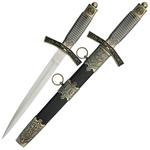The History of the Dagger
29th Jul 2014
Swords and sword fighters naturally get most of the attention in action and adventure films. There's nothing like watching a pair of combatants flail away at each other, parrying and thrusting as they work their way up and down castle staircases. Against such grand backdrops, a humble weapon such as a dagger would seem to be useless. But that's not entirely the case.
The dagger dates to human prehistoric times, when it was fashioned out of ivory, flint or bone. Eventually, as man began to work with metals and alloys, daggers were fashioned out of copper –as early as the third millennium BCE, which predates the swords that were made during the Bronze Age.
From practically the earliest of times, daggers were designed with hilts, sometimes of a decorative nature. The decorative additions sometimes signified levels of power – even today, military officers occasionally wear dress daggers.
Ove the centuries, daggers took on various styles and qualities, depending on how people wished to make best use of them.
Roman soldiers were issued a double-edged iron weapon that held a blade ranging anywhere from 7 to 12 inches. The weapon, designed for close combat, was regarded as a Roman soldier’s final line of defense. And when not needed for waging war, the instrument served as something of a utility knife.
Medieval daggers, such as the stiletto, were fashioned to facilitate thrusting attacks. Some daggers from this historical period ceased to be sharpened to a cutting edge, as the advent of armor and chain mail rendered cutting actions useless in battle. A narrow blade designed for thrusting, on the other hand, might find its way through armor or mail at various joint areas.
During the Renaissance, daggers were commonly worn; they were often the only weapon permitted to be carried by commoners. During the 17th century, the dagger was adapted to bayonet form, permitting rifles and muskets to double as spearing weapons.
The trench warfare which characterized World War One encouraged greater use of the dagger. And the weapon’s ceremonial use was also taken advantage of by Italian and German officers during World War Two.
The most common form of the dagger these days is the boot knife, which is short enough to be concealed and carried in a special case strapped to the lower leg. The weapon’s connotation these days is twofold: That of treachery and deception owing to its ability to be hidden, or, because of the courage it takes to use it in close quarters, of daring and bravery.

